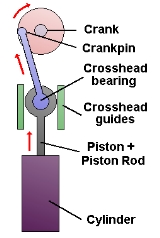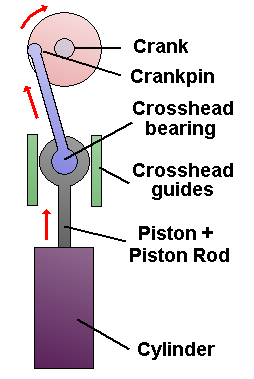
Crosshead bearing
Encyclopedia

Reciprocating engine
A reciprocating engine, also often known as a piston engine, is a heat engine that uses one or more reciprocating pistons to convert pressure into a rotating motion. This article describes the common features of all types...
s to eliminate sideways pressure on the piston.
Usage
On smaller engines the connecting rodConnecting rod
In a reciprocating piston engine, the connecting rod or conrod connects the piston to the crank or crankshaft. Together with the crank, they form a simple mechanism that converts linear motion into rotating motion....
links the piston
Piston
A piston is a component of reciprocating engines, reciprocating pumps, gas compressors and pneumatic cylinders, among other similar mechanisms. It is the moving component that is contained by a cylinder and is made gas-tight by piston rings. In an engine, its purpose is to transfer force from...
and the crankshaft
Crankshaft
The crankshaft, sometimes casually abbreviated to crank, is the part of an engine which translates reciprocating linear piston motion into rotation...
directly, but this transmits transverse forces to the piston, since the crankpin (and thus the direction the force is applied) moves from side to side with the rotary motion of the crank. These transverse forces are tolerable in a smaller engine; a larger engine's much greater forces would cause an intolerable degree of wear on the piston and cylinder
Cylinder (engine)
A cylinder is the central working part of a reciprocating engine or pump, the space in which a piston travels. Multiple cylinders are commonly arranged side by side in a bank, or engine block, which is typically cast from aluminum or cast iron before receiving precision machine work...
, as well as increasing overall friction in the engine.
A piston rod
Piston rod
In a piston engine, a piston rod joins a piston to a connecting rod.Many internal combustion engines, and in particular all current automobile engines, do not have true piston rods, and the term piston rod is often used as a synonym for connecting rod in the context of these engines.All engines...
is attached to the piston and links it to the crosshead, which is a large casting sliding in crosshead guides (UK: slidebar), allowing it only to move in the same direction as the piston travel. The crosshead also houses the gudgeon pin on which the small end of the connecting rod pivots. In this way, the transverse forces are applied only to the crosshead and its bearings, not to the piston itself.
Internal combustion engines using crossheads make for easier maintenance of the top end of the engine, since the pistons can be easily removed. The piston rod is mounted on the underside of the piston and connected to the crosshead by a single nut in double acting engines.
Large diesel engines (such as those fitted to ships) are of this pattern; the vast majority of steam engines are also built this way.
In the case of the steam engine
Steam engine
A steam engine is a heat engine that performs mechanical work using steam as its working fluid.Steam engines are external combustion engines, where the working fluid is separate from the combustion products. Non-combustion heat sources such as solar power, nuclear power or geothermal energy may be...
, a crosshead is essential if the engine is to be double acting - steam is applied to both sides of the piston, which requires a seal around the piston rod.
The same applies to double acting diesel engines (see also: H class battleship (1939): 12 MAN double-acting 2-stroke 9-cylinder diesels).
Crossheads in a steam locomotive
Steam locomotive
A steam locomotive is a railway locomotive that produces its power through a steam engine. These locomotives are fueled by burning some combustible material, usually coal, wood or oil, to produce steam in a boiler, which drives the steam engine...
can be mounted either to one guide mounted above the crosshead or to two, one above and one below (called an alligator crosshead since it has two "jaws"). The former was preferred in many modern locomotives.
Large diesels often have a plunger oilpump directly attached to the crosshead to supply oil under high pressure to the crosshead bearing.
In many 19th century marine steam engine
Marine steam engine
A marine steam engine is a reciprocating steam engine that is used to power a ship or boat. Steam turbines and diesel engines largely replaced reciprocating steam engines in marine applications during the 20th century, so this article describes the more common types of marine steam engine in use...
s, the crosshead was a strong metal bar attached to the piston rod and perpendicular to it, which was sometimes used to eliminate transverse forces, as in a steeple engine, and at other times used as a linkage—to side-rods in a side-lever engine or to connecting rods in a square engine.

